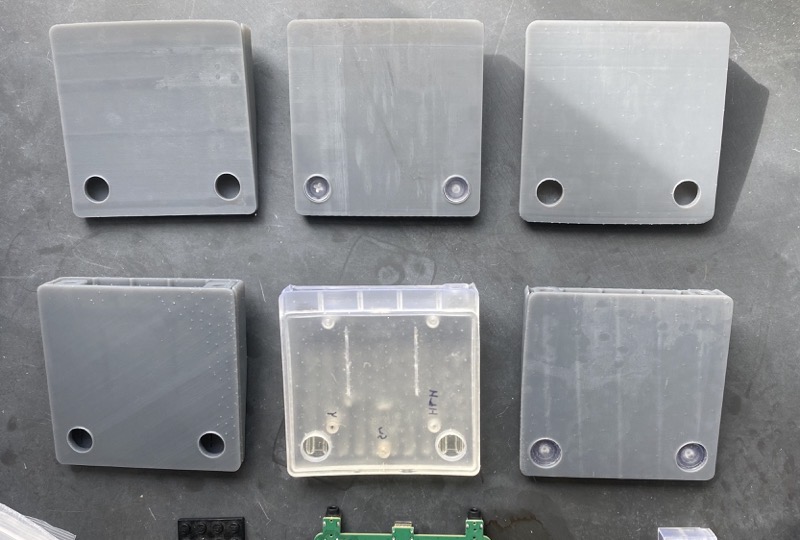Since the last update, we’ve largely been sweating increasingly smaller details in the same areas as before, but it’s not all been forward motion. In any engineering project, setbacks are expected, and we had a few in the last month—though nothing major. We appreciate the comments to keep quality a priority over speed—it takes some pressure off and lets us do what we need to do.
Mechanicals
This has continued to be my main task. In the last update, I shared a photo of printed prototypes up to v6. We’re printing v14 now, though many of the differences are not really apparent in the photo above.
Molds
As I mentioned previously, tooling is our single biggest expense, so it wasn’t pleasant when I sent near-final designs to the mold maker and got 30% higher prices. I had to take a step back. After a lot of back and forth with them, I’ve come to a design that takes slightly more assembly time but should be overall less costly, provide better protection against water ingress and more consistent quality. Instead of an annular snap fit (think Tupperware) that’s complicated to tool, it’ll have a friction fit that can be secured with a screw.


After another week or two of printing and testing prototypes on a local Form 3 (from fellow Kickstarter/MIT alumni FormLabs), I’ll send out for a more accurate PolyJet print to confirm the final design, and then shoot it off to the mold maker. Once that’s done, I’ll finally be able to focus on software.
Sourcing
Component sourcing is an ongoing task. Given sufficient automation, parts’ cost is driven by the amount of material in them, and the miracle of silicon components is that they’re inexpensive to make in large quantities. Parts with a physical function are more expensive, so talking to manufacturers directly is usually a better deal and you can specify exactly what you want.

I’ve gotten lots of connector and fastener samples, and magnet samples are coming next. We’ve found a good partner to make the custom cables we designed so that cartridges don’t have to be attached directly to Pickup. Once Pickup’s design is 100% done, we’ll send that job out.
Firmware

Jeremy’s got things running on several proto boards, with raw data getting spit out via MQTT. Right now its purpose is mostly to test the hardware. He’s testing power consumption of the different circuits right now.
Electronics
Jeremy’s been requesting final production quotes from a range of PCB fabs, which I think is not one of his favorite activities, but he does it for you. We’ve made boards both here and in China, but one of our goals is to make things local when possible.

We got some domestic quotes that were higher than the actual price of Pickup—you can tell that fabs around here are expecting either volume in the hundreds of thousands, or that you’re making some kind of military or industrial product that has a fat margin. And several others never got back to us at all. Jeremy says, “I can’t even consider building in the US if US based suppliers won’t respond to an e-mail!” Guess we’re not a good fit.
Asian fabs we’ve worked with are focused on customer service, providing both good prices and quality quickly. They’ve automated a lot of what they do so that they can handle smaller customers, and consider it an investment in future relationships.
Part change
One wrench that we discovered while getting quotes: our chosen Silicon Labs microcontroller was placed on a restricted export list since we picked it. To be an electrical engineer you need to keep up with geopolitics. Its encryption module means that it’s difficult to get in China, where we’re getting the boards assembled.
Fortunately, we don’t use that functionality, so Jeremy found an alternative from ST that does not have this problem. You’d think that changing the supposed brain of Pickup would be a huge deal, but its job is straightforward in our architecture and Jeremy has a head start from years of experience working with these ST chips. The feature set should not change, but it means that we’re going to have to take several more weeks to change the board and the firmware we’ve written so far. The schedule impact sucks, but it’ll greatly reduce risk now, and give us a sure foundation for the future. These new boards are our top priority.
I told Jeremy, “It’s weirdly reassuring because I expected some wrench to come.” Hopefully that was the big one.
Cartridges
We’ve been working on sensor cartridges as well. Jeremy ordered first boards for spectrum, distance, CO2 and VOC. The dimensions for a through-hole part were wrong the first time, so we’re reordering. He’ll be hand-assembling the boards once everything comes back.
Because these are each relatively low volume, they’ll have a common injection-molded case paired with a commercially printed fascia. Additive manufacturing isn’t everything we were promised, but for low-volume production, it’s perfect now.

Jeremy will update you with a deeper dive into his work in a week or two. As always, we appreciate your patience and trust during our slog. I can’t wait to get to the fun part, either.
Crossposting from Pickup Kickstarter update #4
